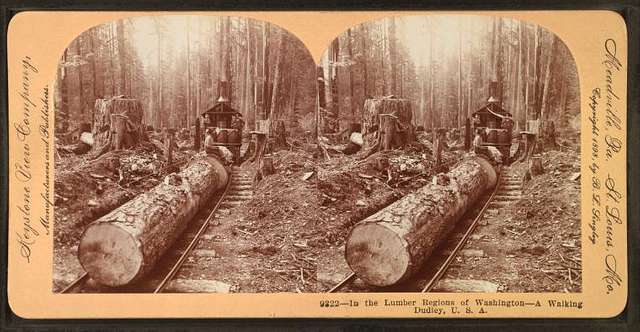Despite cyclical economic conditions, our state’s wood products story remains a separate and dramatic story through local history.
The beginning of this great activity may have begun in 1788 when English Captain John Meares took a shipload of Puget Sound spars to China. He never made delivery. A fierce storm caused him to jettison his load mid-Pacific. Four years later another English Captain named George Vancouver replaced a broken spar with a Puget Sound tree.
Wood was used in the construction of fur-trading posts, of course, which led to the processing of logs for a variety of domestic and commercial use. In 1825, a Vancouver, Washington millwright named William Cannon first whipsawed logs into boards. The Hudson’s Bay Company, with headquarters then at Fort Vancouver, accepted shakes and shaved shingles from American settlers in exchange for general supplies.
The first “permanent” mill on Puget Sound was built by Michael T. Simmons at Tumwater, Washington. Simmons had the moxie and skill to successfully utilize discarded machinery from the Ft. Vancouver mill to undertake his new business.
Seattle co-founder Arthur Denny and his neighbors used the great trees looming over their heads to sell to visiting ships. In 1852, the Alki settlement on Elliott Bay sent a cargo of pilings to booming San Francisco. Oxen were borrowed from settlers in the Puyallup Valley to move those monsters.
Later, mills were built at Whatcom Creek near today’s Bellingham and at Tacoma. An early Tacoma mill is remembered for a flaw: it sawed boards on the bias, tapering them from end to end, creating interesting problems for some users. An 1853 edition of the Columbian, the newspaper of record at that time, reported that “fourteen sawmills” were in operation on Puget Sound, most of them run by waterpower from nearby streams and rivers.
Seattle’s be-whiskered Henry Yesler completed his sawmill on Seattle’s central waterfront in 1853. His site and the steep hill behind, down which logs skidded to his mill, gave birth to the term “Skid Road.”
Washington Territory’s timber reached a point of pride in 1866 when local loggers sent a 150-feet-tall flagstaff to the Paris Exposition. Despite that creative boosterism, the Eiffel Tower took all the notoriety in that grand show.
By 1880, the lumber industry employed 1,687 persons — “fallers,” “buckers” and others, contributing 57 percent of the value all Washington Territory’s manufacturing. Railroad transportation and the use of power equipment such as the “donkey engine” brought wood products into a new era. Capital poured in from the Midwest, including a family named Weyerhaeuser. By 1900 Washington was 5th in the nation among lumbering states.
Despite efforts to save and respect remaining stands of timber in Washington state, the industry has remained a central player in the local economy.
Discover more from Post Alley
Subscribe to get the latest posts sent to your email.
